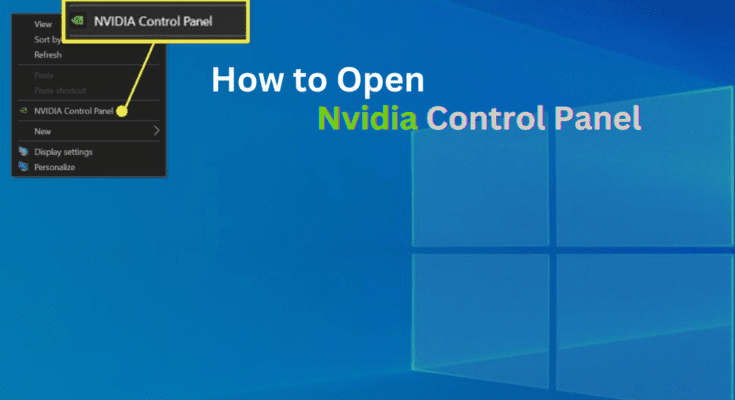How to open Nvidia Control Panel is a significant instrument for clients of Nvidia design cards. It offers exhaustive choices to adjust and streamline illustration settings for different applications. Whether you’re a gamer, an expert visual fashioner, or essentially hoping to upgrade your PC’s visual exhibition, understanding how to get to and use the Nvidia Control Panel can further develop your client experience.
Technical Details
Guaranteeing your framework meets the necessities is crucial for making the most out of the Nvidia Control Panel. The control panel is viable with different working frameworks, including Windows 10, 8.1, 8, and 7, as well as particular adaptations of Linux. It requires a Nvidia illustrations card with refreshed drivers introduced.
Updating your drivers is vital for accessing the latest features and maintaining compatibility.
Applications
How to open Nvidia Control Panel serves multiple purposes across different user groups:
- Gaming: Customize settings to achieve optimal performance and visuals.
- Professional Graphics Work: Adjust settings for software like Adobe Photoshop and Autodesk Maya.
- General System Performance Optimization: Enhance overall system stability and performance.
Benefits
Using the Nvidia Control Panel offers several advantages:
Enhanced Graphics Performance: Tailor settings to match your needs, ensuring smooth and top-notch visuals.
Customizable Settings: Control various graphics settings, including resolution, refresh rate, and variety of profundity.
Further developed User Experience: Optimize your system for various applications, giving a more tailored user experience.
Challenges and Limitations

Despite its benefits, the Nvidia Control Panel is not without its challenges:
- Common Issues: Users may encounter problems such as the control panel not opening, settings not applying, or crashes.
- Limitations: Some advanced features may be unavailable on older graphics cards or operating systems.
Latest Innovations
Nvidia continuously updates its control panel with new features and improvements. Recent updates have introduced enhanced support for ray tracing, AI-powered settings optimization, and better multi-display management.
Future Prospects
Looking ahead, we expect Nvidia to continue innovating, with potential advancements in AI integration, deeper customization options, and improved support for emerging technologies like VR and AR.
Comparative Analysis
Comparing the Nvidia Control Panel with other graphics management tools:
- AMD Radeon Software: Offers similar features but has a different interface and some unique settings.
- Integrated Graphics Control Panels: Typically less powerful and with fewer customization options than dedicated GPU control panels.
User Guides or Tutorials
Here’s a step-by-step guide to opening and using the Nvidia Control Panel:
Here’s a step-by-step guide to opening and using the Nvidia Control Panel:
Step-by-Step Guide to Opening the Nvidia Control Panel
Right-click on Desktop: On your Windows desktop, right-click to open the context menu.
Select Nvidia Control Panel: From the menu, click on “Nvidia Control Panel.”
Navigating Through the Nvidia Control Panel

Once open, the control panel is divided into several sections:
- Adjust Image Settings with Preview: Customize settings with a visual preview.
- Manage 3D Settings: Adjust settings for individual applications or globally.
- Set PhysX Configuration: Optimize your system for PhysX, Nvidia’s real-time physics engine.
Adjusting Display Settings
- Change Resolution: Select your preferred resolution and refresh rate.
- Adjust Desktop Color Settings: Modify color depth, brightness, contrast, and gamma.
Managing 3D Settings
- Global Settings: Apply settings globally for all applications.
- Program Settings: Customize settings for specific applications.
Configuring PhysX Settings
- Select Processor: Choose between CPU or GPU for PhysX processing.
- Set Preferred Device: Optimize performance by selecting the most suitable device.
Setting Up Multiple Displays
- Configure Surround, PhysX: Manage multi-display setups for an immersive experience.
- Adjust Desktop Size and Position: Fine-tune display alignment and positioning.
Troubleshooting Common Problems
- Control Panel Not Opening: Ensure drivers are updated and reinstall if necessary.
- Settings Not Applying: Check for conflicts with other software and ensure proper permissions.
Conclusion
The Nvidia Control Panel is an indispensable tool for anybody using a graphics card. It provides extensive options to optimize and customize your system’s graphics execution. Users can upgrade their general insight, whether for gaming, professional work, or general use, by understanding how to access and explore through the control panel. As Nvidia continues to improve, the fate of graphics streamlining looks promising, with potential advancements that will further upgrade user capabilities.




